
|

Our professional partners prescribe orthotics to their patients for various symptoms.
Many medical conditions often stem from a biomechanical gait abnormality that can
be treated with custom orthotics. Here are some common ailments related to poor
foot biomechanics.
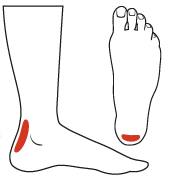
|
Achilles Tendonitis
Achilles Tendonitis is an inflammation of the common tendon of the gastrocnemius
and soleus muscles of the posterior compartment of the leg.

Patients that have equinis deformity and/or run up-hill are candidates for this disorder.
As the tibia moves over the foot, the ankle joint needs to be able to dorsiflex
at least 10 degrees. If this is not possible, due to tightness of the aforementioned
musculature, the tissues of the tendon can be damaged. In addition it is thought
that over-pronation may reduce the blood supply to the area by "wringing out"
the arterial blood supply to the tendon. This is due to the twisting movement of
the tendon associated with over-pronation of the foot.

|
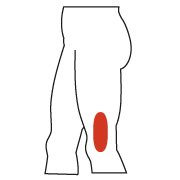
|
Iliotibial Band Syndrome
The iliotibial band which is a thick extension of the tensor fascia latae muscle
slides over the lateral epicondyle. Iliotibial Band Syndrome is an inflammatory
reaction at the side where this sliding occurs.

If the foot over-pronates, this is accompanied
by internal rotation of the entire lower limb, producing a constant friction between
the band and the bony prominence of the femur. It is therefore very common among
runners especially if they run on a banked track or downhill.

|

|
Metatarsalgia
Metatarsalgia is not an injury; it's actually a symptom or a group of symptoms.
These may include pain in the ball of the foot, with or without bruising, and inflammation.
It is often localized in the metatarsal heads or it may be more isolated, in the
area near the big toe. One of the hallmarks of this disorder is pain in the ball
of the foot during weight-bearing activities. Sharp or shooting pains in the toes
also may be present, and pain in the toes and/or ball of the foot may increase when
the toes are flexed. Accompanying symptoms may include tingling or numbness in the
toes. It is common to experience acute, recurrent or chronic pain as a result of
this problem.


Metatarsalgia develops when something changes or threatens the normal mechanics
of the foot. Ultimately, this creates excessive pressure in the ball of the foot,
and that leads to metatarsalgia. Some of the causes of metatarsalgia include:
• Being overweight: the more weight is brought to bear on the foot, the greater the
pressure is on the forefoot when taking a step.
• As men and women age, the fat pad in the foot tends to thin out, creating less cushioning
and making them more susceptible to pain in the ball of the foot.
• Wearing shoes that do not fit properly: Shoes with a narrow, tight toe box, or shoes
that cause a great deal of pressure to be put on the ball of the foot (high heels,
for example) are often the cause of metatarsalgia. Because such footwear inhibits
the walking process and forces the wearer to alter his or her step to adjust to
the shoe, the mechanics of the foot are compromised.
• Certain foot shapes contribute to metatarsalgia. A high-arched foot, or a foot with
an extra-long metatarsal bone can cause pressure on the forefoot region and contribute
to pain and inflammation there.
• Claw toes or hammertoes can press the metatarsals toward the ground and cause stress
on the ball of the foot.
• Arthritis, gout or other inflammatory joint disorders can produce pain in the ball
of the foot.

|
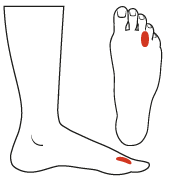
|
Morton's Neuroma
Morton's Neuroma is a thickening of the tissue that surrounds the intermetatarsal
nerve leading to the toes. When the nerve becomes squeezed and irritated, it causes
painful symptoms. Neuroma patients occasionally complain of a "pins and needles"
sensation that spreads through their fourth and fifth toes, or of a feeling akin
to hitting their "funny bone."

A neuroma can occur in response to the irritation of a nerve by one or more factors:
• Abnormal foot function or foot mechanics: primarily excessive pronation that causes
strain on the nerve.
• Improper footwear: constricting, narrow, poor-fitting shoes with a tight or pointed
toe box tend to compress the end of the foot, leading to excessive pressure in the
area of the nerve. High-heeled shoes are a particular culprit here.
• Previous trauma to the foot: Those who engage in high-impact activities that bring
repetitive trauma to the foot (running, aerobics, etc.) have a greater chance of
developing a neuroma.

|
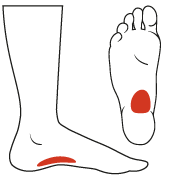
|
Plantar Fasciitis
Plantar fasciitis is an inflammatory condition that occurs where the plantar fascia
attaches to the medial tuberosity of the calcaneus.

Over-pronation results in a constant tugging of the aforementioned attachment site.
Inflammation then results from this constant insult to the local tissues. When the
patient is off-weight bearing, scar tissue begins to repair the site of injury.
When the patient resumes weight-bearing, the scar tissue is torn resulting in acute
pain. This explains why patients with this disorder typically experience the most
pain when they get out of bed, or stand after a period of sitting.

|
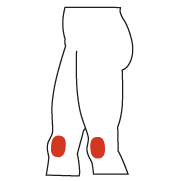
|
Runner's Knee
Runner's Knee is a general term referring to pain around the front of a runner's
knee.

If the pain is anteromedial in location, the source of the problem may be over-pronation.
The internal rotation of the tibia associated with over-pronation, may cause the
knee to fall into a functional valgus orientation during the stance phase of gait.
This in turn will compromise the ligaments on the medial aspect of the knee. Furthermore,
the abnormal motion will result in abnormal pressures behind the patella, leading
to a more specific knee malady referred to as chondromalacia patella.

|

|
Sacroiliac Syndrome
Sacroilliac syndrome is a painful inflammatory condition of the sacroiliac joints.
The patient generally experiences pain in the buttock and thigh regions. It is
typically aggravated by sitting for long periods.

Quite frequently it is caused by an injury such as would be sustained by a fall
on the buttocks or during a lifting activity. However, there is some evidence to
suggest that a chronic irritation from abnormal foot mechanics is also a possible
cause. When a foot over-pronates, it creates a tendancy towards internal rotation
of the lower limb. Due to the anatomy of the hip joint, this internal rotation translates
into an extension of the pelvis (PSIS's rotate upward while ASIS's rotate downward).
If the mechanics of the feet are not symmetrical, then conflicting rotations may
occur at the two sacroiliac joints. This appears to set up a chronic irritation
of these joints leading to the inflammation.

|
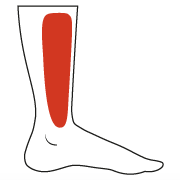
|
Shin Splints
The condition known as Shin Splints involves a muscular over-use scenario. There
are Anterior Shin Splints and Posterior Shin Splints. Anterior Shin Splints involve
the Tibialis anterior muscle of the anterior compartment of the leg, and Posterior
Shin Splints involve the Tibialis posterior muscle of the posterior compartment
of the leg.


Both of these muscles are involved in slowing
down pronation during the stance phase of gait. Tibialis anterior functions early
in the stance while Tibialis posterior functions a little later. If the patient
over-pronates or pronates too rapidly, either or both of these muscles may be called
upon to work harder than normal. As a result, fatigue sets in, leading to inefficient
force production which leads to micro-tearing of the soft tissue and therefore and
inflammatory reaction. Since the muscle is wrapped in a fascial covering, the swelling
that occurs from the aforementioned problem is restricted by this covering. Beyond
the fact that much pain results from the entire process, the presuure within the
fascial covering can be suffiecient to "choke-off" the blood supply to
the involved musculature, further added to the insult on the tissue. In severe circumstances
the swelling can be severe enough to damage the deep peroneal nerve resulting in
a permanent "foot drop," as this nerve supplies the dorsiflexors of the
foot. The scenario that typically brings on "shin splints" is a sedentary
individual that suddenly starts running or walking long distances. When that individual
is also an over-pronator, the combination of having weak muscles from lack of activity
and having this biomechanical fault increase the likelihood of injury. Even changing
the type of shoe worn during walking or running can be sufficient to increase the
pronation of the subtalar and transverse tarsal joints and lead to tissue injury.

|
|